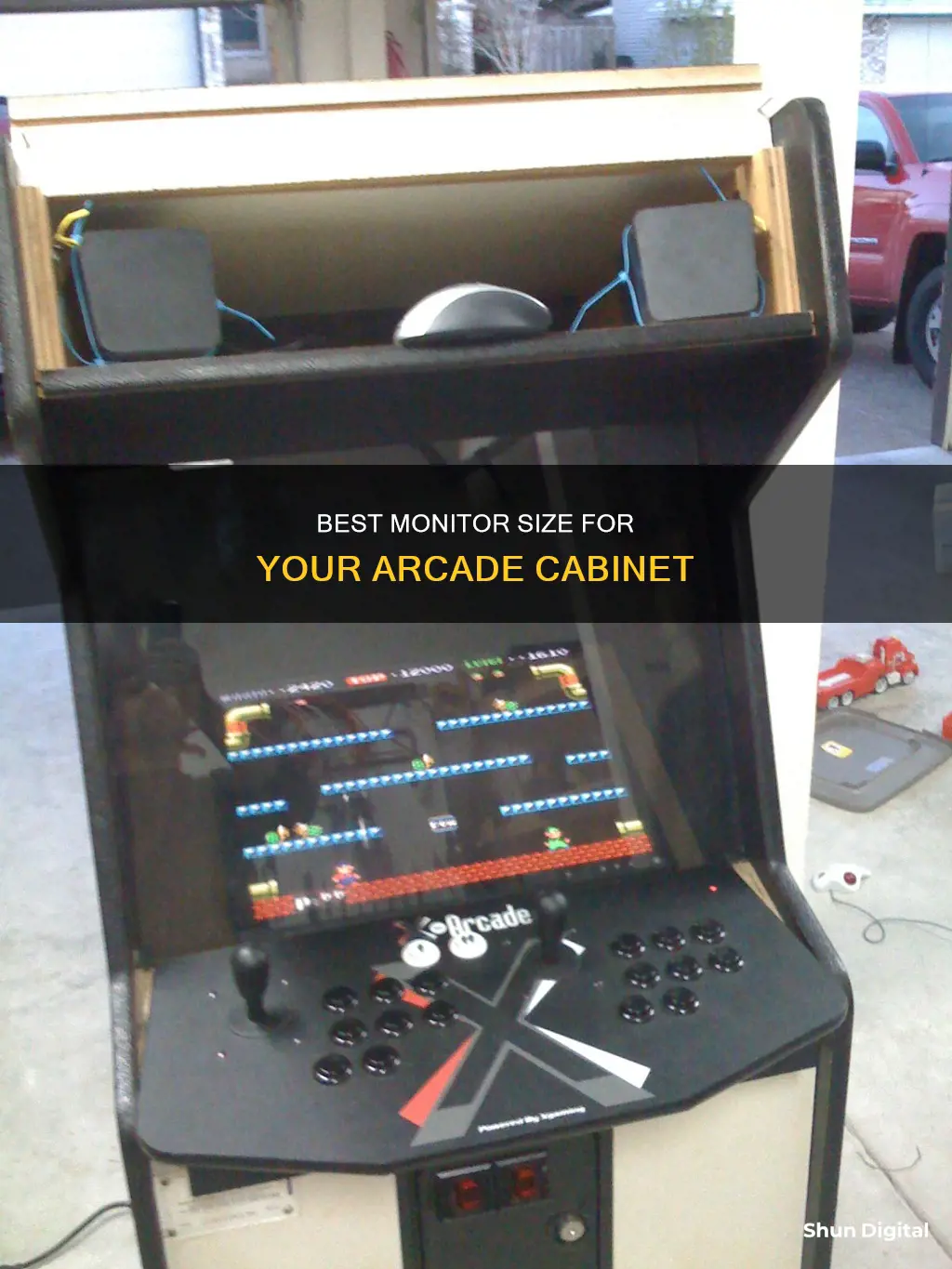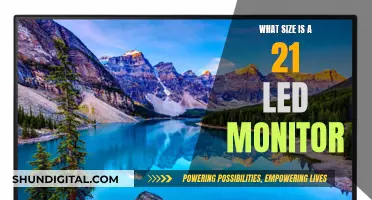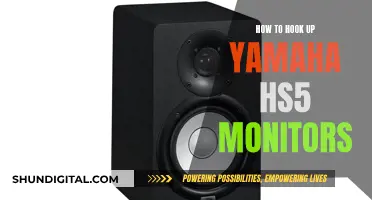
The size of a monitor for an arcade cabinet depends on the type of arcade cabinet and the desired level of authenticity. Classic arcade video game cabinets typically come in three styles: upright (standard), cabaret (smaller upright), and cocktail (tabletop sit-down). The size of the monitor also depends on the orientation of the games being played, with classic vertical games requiring smaller monitors than modern landscape games. While modern arcade cabinets often use widely available 16:9 TFT monitors, some enthusiasts prefer CRT monitors for a more retro feel. The size of the monitor also depends on the space available in the arcade cabinet and the desired level of portability.
| Characteristics | Values |
|---|---|
| Typical arcade cabinet screen size | 19" (vertically mounted) for classic vertical games, 25" for modern landscape games |
| Japanese arcade machine screen size | 29" (27" viewable) |
| Minimum screen size | 14" |
| Screen type | CRT, LCD/LED, TFT |
| Aspect ratio | 4:3, 16:9 |
| Screen resolution | 1440p, 4K |
| Motion blur | Motion blur reduction, software-based BFI |
| Screen orientation | Vertical, horizontal |
| Cabinet style | Upright (standard), cabaret (smaller upright), cocktail (tabletop sit-down) |
What You'll Learn

19 for classic vertical arcade games
If you're building an arcade cabinet, the size of the monitor is an important consideration. The size you choose will depend on the type of games you want to play and the overall dimensions of your cabinet.
For classic vertical arcade games, a 19-inch monitor is the typical size. This measurement refers to the diagonal size of the original CRT monitor for which the cabinet was designed. While CRT monitors were once standard, they have since been replaced by LCD/LED monitors, which are available in a variety of sizes.
A 19-inch monitor will fit most stand-up and cocktail arcade game cabinets. This size was used for many classic arcade games, including Midway classics like Ms. Pac-Man, Pac-Man, and Galaga, as well as Nintendo classics like Donkey Kong and Donkey Kong Jr.
When choosing a 19-inch monitor for your arcade cabinet, you'll want to consider the resolution, response time, and compatibility with different game boards. Some monitors are designed specifically for gaming, with features like a high contrast ratio and wide viewing angles. You'll also want to make sure the monitor has the correct inputs and outputs for your setup.
- The RetroArcade.us 19-inch Arcade Monitor is a complete package that includes a CRT mount for upright cabinet replacement. It has a 450:1 contrast ratio and is compatible with Jamma and MAME boards.
- The UNICO 19-inch Arcade Replacement Screen has a resolution of 1280 x 1024 pixels and a response time of 8 milliseconds. It is designed for easy installation and is compatible with CGA and EGA game arcades.
- The Vision Pro LCD Arcade Game Monitor Kit comes in a 19-inch size and is designed for arcade cabinets.
Monitoring Natural Gas Usage: Efficient Strategies for Conservation
You may want to see also

25 for modern landscape games
If you're building an arcade cabinet, the size of the monitor will be a key consideration. For modern landscape games, a 25" screen is typically used. This is a reference to the diagonal size of the original CRT monitor for which the cabinet was designed. While CRT monitors were once the standard, they have since been replaced by LCD/LED monitors, which are available in a variety of sizes.
When choosing a monitor for your arcade cabinet, it's important to consider the type of games you'll be playing. For modern landscape games, a larger screen size like 25" is generally more suitable as it provides a wider field of view and can enhance the overall gaming experience. This size is commonly used for 4-player upright cabinets and is ideal for games such as WWF WrestleFest, TMNT, The Simpsons, and X-Men.
It's worth noting that the size of the arcade cabinet itself will also play a role in determining the appropriate monitor size. A 25" monitor typically requires a larger cabinet footprint, such as 28-1/4" wide x 34-1/4" deep for the cabinet itself, and 36-3/4" wide x 39" deep when the control panel is attached. The height of the cabinet can vary depending on casters, typically ranging from 71" to 72" high.
When upgrading to an LCD/LED monitor for your arcade cabinet, it's important to consider the weight difference. A 25" LCD monitor can weigh around 260 lbs, which is significantly more than the palleted shipping weight of a CRT monitor, which is about 310 lbs. Ensure that your arcade cabinet can handle the weight of the monitor to avoid any stability issues.
In summary, for modern landscape games, a 25" monitor is a standard choice for arcade cabinets. This size complements the gameplay experience by providing a suitable field of view for landscape-oriented games. Remember to consider the physical dimensions and weight of the monitor when designing or choosing your arcade cabinet to ensure a seamless integration and enjoyable gaming experience.
Replacing the LCD Monitor Cable on Your Asus Q502LA
You may want to see also

27 for a two-player arcade cabinet
A 27-inch monitor is a suitable size for a two-player arcade cabinet, although it may depend on the aspect ratio of the screen and the type of games being played.
For a two-player arcade cabinet, a 27-inch monitor is a good size, providing a comfortable playing experience for both classic and modern games. If the cabinet is designed with a shallow panel, a smaller screen size of around 22 to 24 inches may be more appropriate, while a wider control panel could accommodate a larger screen of up to 27 inches.
The aspect ratio of the screen also plays a role in determining the ideal size. For a 4:3 aspect ratio, a 27-inch screen is generally sufficient, while for a 16:9 aspect ratio, a larger screen size may be preferred to avoid the game display looking too small.
Additionally, the distance between the players and the screen should be considered. A larger screen can be used if the players will be standing further away, while a smaller screen is more suitable for closer distances.
It is worth noting that some arcade enthusiasts prefer the use of CRT monitors over LCD screens due to their compatibility with older arcade games and the ability to find free or cheap second-hand units. However, LCD screens are more widely available and can be used with modern connections such as HDMI or DVI.
Monitoring Shop Usage: Strategies for Success
You may want to see also

22 for a Dell monitor
If you're looking to build an arcade cabinet, the size of the monitor is an important consideration. The size you choose will depend on the type of games you want to play and the overall dimensions of your cabinet.
A 22-inch Dell monitor can be a great option for an arcade cabinet. This size is slightly larger than the classic 19-inch vertical monitors used in traditional arcade games but smaller than the 25-inch screens used for modern landscape games.
Opting for a 22-inch monitor gives you some flexibility in terms of game choices. You can play classic vertical games and still have some extra screen space, which can enhance your gaming experience. Additionally, a 22-inch monitor is a good choice if you're building a two-player arcade cabinet. It provides enough room for both players' visuals without being too large or overwhelming.
Another advantage of choosing a 22-inch Dell monitor is portability. Dell monitors are known for their lightweight design, making them easier to mount and integrate into your arcade cabinet. Their flat-screen design also saves space compared to bulkier CRT monitors, allowing for a more compact cabinet design.
When selecting a 22-inch Dell monitor for your arcade cabinet, consider the resolution, response time, and connectivity options to ensure it meets your specific gaming needs.
Eye Care Monitors: ASUS's Innovation for Tired Eyes
You may want to see also

24 widescreen monitor
A 24" widescreen monitor is a great option for an arcade cabinet. This size monitor allows for a smaller and lighter cabinet compared to using a CRT monitor. Flat-screen monitors are also easier to mount and are much lighter, making them a more convenient option.
A 24" widescreen monitor is a good size for two-player arcade games, as it allows enough space for controls to be spaced out comfortably. It's important to plan the cabinet size so that the monitor doesn't take up too much space and leave enough room for the players.
When building an arcade cabinet, the screen size is a crucial consideration as it dictates the scale of the project. A 24" widescreen monitor is a popular choice for arcade cabinets as it strikes a balance between modern features and a classic arcade experience.
This size of the monitor is also suitable for a range of arcade games, from classic vertical games to more modern landscape games. It's worth noting that most arcade games used either a 19" or 25" monitor, so a 24" monitor is a good middle ground.
Overall, a 24" widescreen monitor is an excellent choice for an arcade cabinet, offering a good balance of size, weight, and compatibility with various arcade games.
Beware: Your Boss May Monitor Your Internet Usage
You may want to see also
Frequently asked questions
The standard size for an arcade cabinet monitor is 19 inches for classic vertical games and 25 inches for modern landscape games.
For a two-player arcade cabinet, a 27-inch monitor is a good option, but you can go smaller as long as the controls are spaced out enough for players to be comfortable.
Yes, you can use a modern TV or computer monitor for your arcade cabinet. Many people opt for widely available 16:9 TFTs, while others prefer 4:3 displays for a more retro look.
The size of the monitor you need will depend on the type of game you want to play. For example, the Midway classic games like Ms. Pac-Man, Pac-Man, and Galaga use a 19-inch vertical monitor, while games like WWF WrestleFest, TMNT, and The Simpsons use a 25-inch horizontal monitor.







